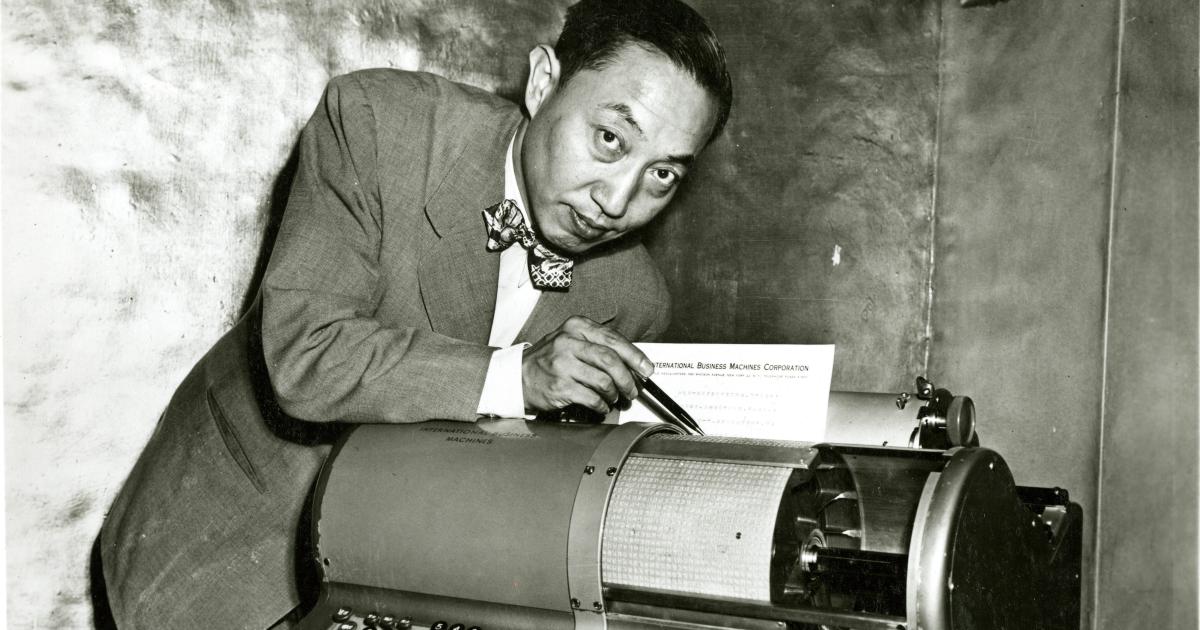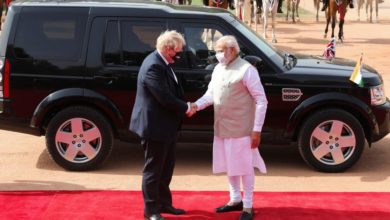The Asian American immigrants behind key technology innovations — Quartz

Why does one of the world’s largest and most successful telecommunications companies have the word “railroad” in its name?
Every semester, I stump the Stanford students in my History of Information class with this query. The company in question is Sprint, which stands for “Southern Pacific Railroad Internal Networking.”
What follows is a brisk lecture on the history of American communications infrastructure that always leaves a few minds blown.
Railroads, I explain, were in many ways the first layer in the history of modern American and global information architecture. With the rise of electric telegraphy, engineers by and large chose to run their cables down the already cleared pathways of railroad lines like the Southern Pacific. Why fell more trees or traverse rivers anew when the work had already been done? Not long after came fiber optics, which followed a similar pattern, laying new infrastructure largely along the train routes that first connected the US more than 150 years ago.
“Who built the railroads?” I then ask. “Chinese immigrants,” a student calls out.
“Exactly,” I respond—not exclusively, of course, but Chinese immigrants to the United States contributed disproportionately to the country’s first transcontinental lines. They did so, moreover, while confronting a period of virulent, and often violent, anti-Chinese prejudice. “Now what about all those other infrastructures we just spoke of? The ones built on top of the railroad? Did the contribution of Asian immigrants and Asian Americans simply stop once the railroad was finished? What about telegraphy? Fiber optics? ARPANET? The internet? Science, technology, engineering, and medicine more broadly?”
At this point, the class begins in earnest. In particular, students are primed and ready to examine the role of Asian immigrants and the broader AAPI community within the creation of our present-day sci-tech infrastructure.
Chung-chin Kao brings IBM to China
“Dear Mr. Watson: It is my great privilege to write you the first typewritten Chinese letter with the typewriter which was achieved only through your foresight and generous support.”
So began the first letter in history to be written on an electric Chinese typewriter—a machine invented in the late 1940s by Chinese American engineer Chung-chin Kao, and built by IBM.
Kao (whose name also appears in the records as Kao Chung-Chin, C.C. Kao, and Gao Zhongqin) was born in China in 1906. In 1936, he went to the UK to study electrical engineering at Marconi College in Chelmsford. Two years later, he traveled to Germany to continue his studies, but his plans were cut short by the outbreak of World War II. In 1942, Kao traveled to the United States.
By 1943, Kao had become chief of the radio department of the Central News Agency of China, and research officer of radio communications for China’s Commission of Military Affairs. His main base of operations was in New York City, at a workshop on East 37th Street. It was here that Kao began work on his big new project: to build the first electric typewriter for the Chinese language.
Like so many inventors and engineers of his day, Kao’s first thoughts turned to IBM, and to hopes of establishing a research and manufacturing partnership with the global juggernaut. In the early 1940s, Kao presented initial sketches of his machine to company engineers and executives, and a relationship grew from there. It reached fruition in 1947, with the debut of the machine.
Courtesy of the Smithsonian
To type a Chinese character, one pressed a total of four numeric keys on the keyboard, more or less simultaneously (compared by one observer at the time to playing a chord on the piano). These four-digit codes were used to locate the typist’s desired Chinese character, providing the machine with that character’s “address” on a metal drum revolving inside the machine’s gun-metal gray chassis. Spinning continuously at a speed of 60 revolutions per minute, the drum measured 7 inches in diameter, and 11 inches in length. Its surface was etched with 5,400 Chinese characters, along with letters of the English alphabet, punctuation marks, numerals, and other symbols—5,400 characters and symbols in all, each with its own, unique, four-digit code—a marvel of design and engineering for its day and age.
Knowing what know today about IBM’s presence in Asia, it might seem self-evident why IBM would have set about building an electric typewriter for the Chinese market. It was less obvious in the 1940s. Kao’s electric Chinese typewriter was one of IBM’s first major Chinese-specific products, and at that point its largest. Although the machine itself was never brought to market—foiled by the civil war then raging in China, which made investors understandably hesitant—nevertheless the project augured a future in which IBM would invest ever more heavily in east Asian markets.
Chan Yeh and the computerization of Chinese
In the second half of the 20th century, IBM continued to attract many of the world’s most brilliant Asian and Asian American engineers. A prime example was Taiwanese American engineer, inventor, and entrepreneur Chan Yeh. Born in Taiwan, Yeh served as an interpreter during the Korean War, later migrating to the US and enrolling in the Northrop Aeronautical Institute (now Northrop University) in Inglewood, California. He went on to work as a cargo aircraft mechanic at Slick Airways in Burbank before entering the Virginia Military Institute. His intention was to major in history. Due to his poor English language proficiency at the time, however, Yeh worried that he might fail out of the program. He decided to pursue electrical engineering instead.
But Yeh never lost his passion for history, which he nourished by attending a lecture at VMI by Arnold Toynbee on the rise and fall of civilizations. Toynbee’s final lecture focused on China, which, as anyone familiar with Toynbee’s work would know, constituted a major outlier in his study. Unlike the other civilizations examined in Toynbee’s classic—all of which rose and then fell—China had endured.
Toynbee credited the persistence of Chinese civilization to Chinese writing: a unifying medium that, despite China’s immense size and diversity—notably the myriad dialects like Cantonese and Fujianese that formed mutually unintelligible languages unto themselves—served as a check on trends that had pulled apart so many other empires and civilization. Chinese script “holds people together even though they are ruled by other countries,” Yeh once explained to me, “so they always come back together.” He continued:
“So, at that time, I thought that, with all the knowledge I had about technology—mechanical, electrical, electronic—and a Chinese person’s understanding of Chinese characters themselves, I must do something to preserve this culture.”
Yeh graduated in 1960 with a BS in electrical engineering, with a focus in military science. He went on to pursue graduate degrees at Cornell University, receiving his MS in nuclear engineering in 1963, and then his PhD in Electrical Engineering in 1965. Upon graduating, Yeh joined IBM. Specializing in automatic control, he developed computational systems to manage industrial processes within paper mills, petrochemical refineries, steel mills, sugar mills, and the like. He was stationed in IBM’s still relatively new offices in San Jose, California, to work on developing simulations of large-scale manufacturing plants.
While working with IBM, he dedicated his spare time to exploring an entirely different venture—the electronic processing of Chinese characters. He felt convinced it should be possible to digitize Chinese characters, and thereby bring Chinese writing into the computer age. Yeh nicknamed his side-venture “Iron Eagle,” on account of the Chinese characters that he first digitized: ying (eagle) and tie (iron).
Courtesy of the Thomas S. Mullaney East Asian Information Technology History Collection, Stanford University
“Iron Eagle” immediately caught the attention of Taiwanese brass. Taiwan’s Joint Chiefs of Staff suggested that Yeh quit IBM, and focus on the project full-time. Yeh agreed and attempted to resign, but was convinced by IBM to take a sabbatical year instead, during which he could focus on his side project with greater concentration.
Yeh took a one-year leave of absence from IBM in 1971, serving as a visiting professor of applied mathematics and nuclear engineering at National Tsing Hua University in Taiwan. The following year, he founded a company called Ideographix, opening its doors in Sunnyvale, California, in one of the earliest buildings to be built in Silicon Valley. Yeh would serve as its president and chief engineer, with his brother, Chan Jong (“CJ”), as vice president.
The flagship product of Ideographix was the IPX, a computerized phototypesetting system that would change Chinese printing forever.
Courtesy of the Thomas S. Mullaney East Asian Information Technology History Collection, Stanford University
For roughly the first seven years of its existence, “Iron Eagle”—now renamed IPX—was limited to use by the Taiwanese and American militaries. Two of Yeh’s first major non-military clients were Taiwan’s Telecommunication Administration and the National Tax Administration of Taipei. For the former, Ideographix helped process and transmit millions of phone bills, and dramatically reduced the time needed to produce telephone directories. For the latter, IPX enabled the production of tax return documents on an incomparable scale.
Yeh began to be approached by media outlets, including one of Taiwan’s largest daily newspapers, United Daily News (Lianhebao). At this newspaper, an immense labor force of perhaps as many as 400 typesetters spent all evening setting type for the daily edition. With the introduction of the IPX system, this labor force was reduced to a mere 50, who could suddenly do the job in far less time.
Exploiting this added speed, United Daily News was able to wait longer until going to press, closing the day’s news cycle at 2 am, as compared to competitors who went to press in the late evening. This enabled the paper to scoop its rivals, with a morning edition that included news that broke too late for other papers to cover.
The man who walked through walls: Leo Esaki and the secret life of electrons
Communication technologies were but one of the myriad fields pioneered by Asian immigrants and the Asian American Pacific Islander community. Contributions extended far and wide, to the domains of medicine, engineering, chemistry, and—in the case of Japanese American scientist Leo Esaki—physics.
Born in 1925 in Osaka, Japan, Esaki spent his teenage years surrounded by turmoil, destruction, and death. The experience implanted deep within him a desire to make sense of the world—to be able to peer through the chaotic surface of life, to what he hoped might be a more stable, underlying order. This search for meaning brought him to the study of physics. “In the natural sciences,” Esaki commented in a 2004 interview, “I think physics is certainly the most fundamental.”
Esaki’s early years at the University of Tokyo were punctuated by Allied bombings of the city. Some 12 years later, he would earn his PhD, and g on to join the Tokyo Telecommunications Engineering Corporation—the company we now know as Sony.
It was here that Esaki would make one of his most profound breakthroughs, discovering a then-unknown type of “tunneling” within semiconductor materials. “One may have heard of the story of Dutilleul,” Yale physicist Yu He explained to me in an interview, referring to the protagonist of the science-fiction story The Man Who Walked through Walls. As Esaki discovered, “walking through ‘atomic walls’ is actually a cakewalk in the secret life of the electrons on many modern-day electronic chips. Dr. Esaki was the one who brought this to light.”
In 1957, Esaki and colleagues made the first demonstration of solid tunneling effects in physics, leading to a device that would come to bear his name: the Esaki tunnel diode, the first quantum electronic device. Discovery of the tunnel diode not only laid a foundation for further exploration in the electronic transport of solids, but it also inspired other advances in semiconductor science and electronics. “Esaki’s tunnel diode work ignited a real craze in the semiconductor industry for the device,” Computer History Museum curator David Brock explains. Esaki himself went to pioneer many of these applications.
In 1960, Esaki joined IBM’s Thomas J. Watson Research Center in Yorktown Heights, New York. While at IBM, Esaki and his colleagues pioneered what are known as “designed semiconductor quantum structures,’ such as artificially built superlattices. This concept of man-made superlattices would later influence a wide range of fields, from semiconductors to metals and magnetic materials.
In 1973, Esaki shared the Nobel prize in physics in recognition of his discoveries, going on to receive the IEEE Medal of Honor in 1991 and the Japan Prize in 1998, among other accolades. After moving back to Japan in 1992, Esaki served as president of the University of Tsukuba, a leading Japanese research institution, as well as the Shibaura Institute of Technology. His return to Japan made front-page news, as he was the country’s only living Nobel Laureate in physics.
From the Transcontinental Railroad to Zoom
No single article could ever hope to chronicle the contributions of Asian immigrants and the AAPI community to the sci-tech infrastructure of the US and the world. For every story shared here, there are thousands of others—like that of Korean American engineer Kie Y. Ahn and his research on magnetic films and memory devices (as well as the more than 500 patents that bear his name); or Ajay Bhatt, the Indian American pioneer of the now-ubiquitous USB (Universal Serial Bus); or An Wang, founder of Wang Laboratories; or Jenny Chuang, the brilliant computer scientist who helped make many of Wang’s machines a reality.
Over the past year alone, our digital worlds have been sustained by a host of companies founded by Asian Americans—including YouTube, Airtable, DoorDash, and of course, Zoom. Just as the first Asian immigrants to the US laid the groundwork for the country’s earliest large-scale physical infrastructure, members of every subsequent generation of Asian immigrants in America, and the AAPI community more broadly, have continued to innovate and build an ever-more complex, globally connected world.
Tom Mullaney is a professor of Chinese history at Stanford University, a Guggenheim fellow, and the Kluge chair in technology and society at the Library of Congress. He is the author or lead editor of six books, including “The Chinese Typewriter,” “Your Computer is on Fire,” and the forthcoming “The Chinese Computer”—the first comprehensive history of Chinese-language computing.





